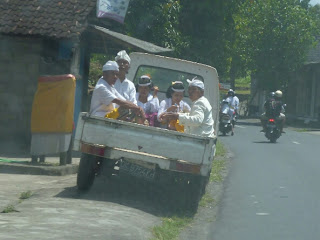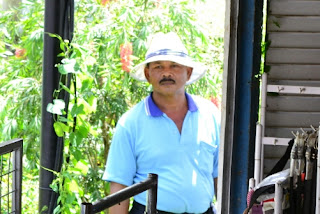Much as we love being here, every so often we are reminded that things are done differently here. This is not Australia, or the US or any other Western democracy. We are living here - as guests - in Indonesia. Sometimes things happen that we are not happy about, but as foreigners we are powerless to act. When I wrote about
this film*, I felt as uneasy as when I was watching it. This post is equally difficult to write.
The latest, very sad problem, concerns
BAWA, who have been doing wonderful work rescuing and rehabilitating Bali's many animals, mainly dogs, but cats and other animals too. Now their licence to operate is under threat and they have been given a very short window to meet stipulated requirements.
There are many rumours flying around about the circumstances. My reading is that the founder's home was
raided recently and the authorities claim that the (11? 13? 16? - it varies) dogs living there did not have rabies immunisation. BAWA of course denies these allegations. Rabies
is certainly back in the area, but it seems highly unlikely that BAWA dogs would be a threat, given that helping eradicate it is their mission.
So what is going on? Maybe it's the forthcoming
APEC summit. With 10 presidents, including Obama, and prime ministers turning up shortly, getting rid of dogs and beggars will create a better look. Every country does it,
even Western democracies, so Indonesia is not alone in scrubbing up. But it's just BAWA, not the other animal welfare groups, that is being targeted and that suggests to me that there is an agenda. I could be wrong but maybe someone has offended someone else, who has a bit of clout, and they have chosen to exercise their power. There are certain mechanisms that make wheels go around here, after all.
Social media here has exploded. And that is a problem. Impulsive outraged posts, not tempered by reflection, are likely to exacerbate the situation by further alienating authority and reinforcing the view that Westerners are meddlesome. Unfortunately there is a coterie of expats who feel they have a duty to save the Balinese from themselves. You see it particularly in the animal sector and the environment. There can be a patronising 'we know best' attitude that can fail to take cultural factors into account. The actual doers, who set up the charities and employ local people to help make genuine change, seem to be sensitive to local conditions, but hasty ill-informed commentary helps nobody.
Many people don't realise that unless they have the correct visa, work - even volunteer work - is not permitted. Visa cancellation, and possible future entry refusal, is a reality. BAWA and other groups would not exist without volunteers, and authorities, until now, have not interfered. This situation cannot be jeopardised for the sake of the many needy charities here.
Fortunately many Balinese people are as upset as the
bules about the BAWA situation. They know who has influence and how best to approach them so that the animals of Bali can continue to receive the help they need. Financial and medical support for BAWA is still required and hopefully with the help of concerned Balinese people, the situation will be resolved quickly.
They do things differently here. It's complicated.
It was very difficult to select an image for this post. There are many very distressing ones on line, and many that are too cute. In the end I chose one that we took ourselves of a lovely healthy fellow in Jl Goutama. Nothing wrong with his legs - he got up and had a good stretch soon after. All Bali dogs should be like him. Unfortunately, even with a collar, dogs like him are disappearing or being poisoned unless the owners keep them in at night.
* Being screened again during the
Ubud Writers and Readers Festival next month.














.jpg)






































